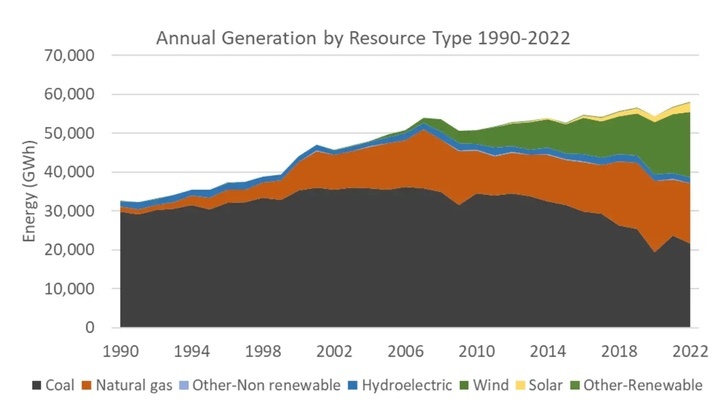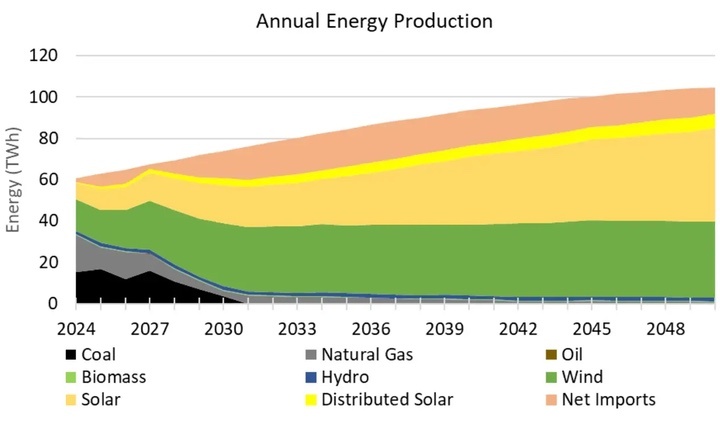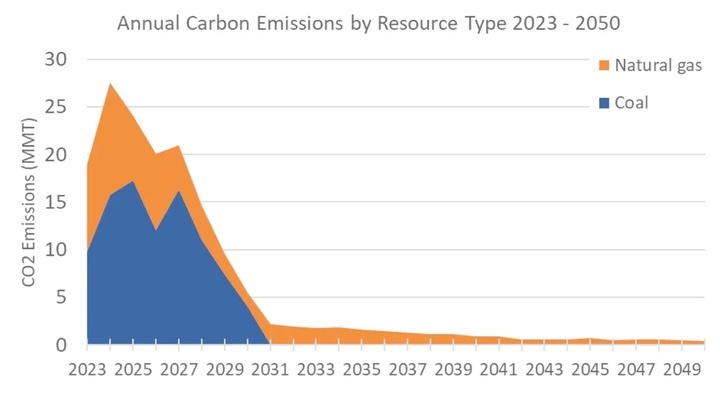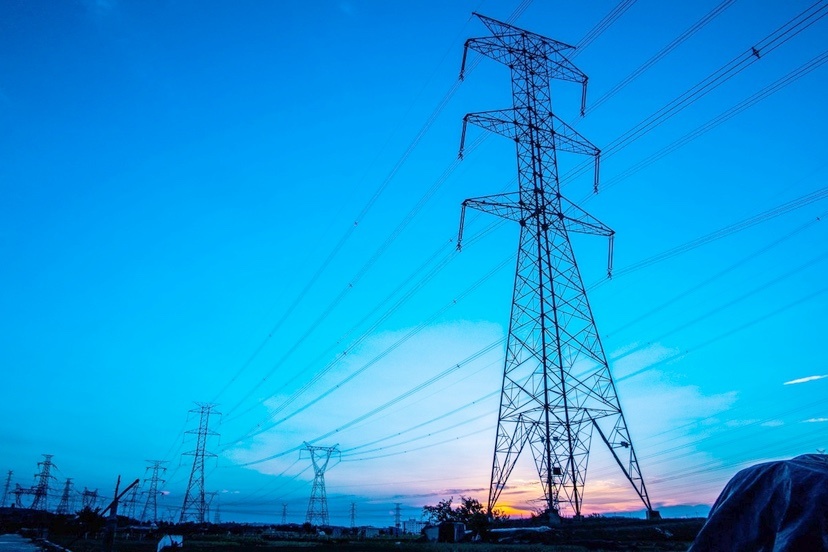This story originally appeared on BigPivots.com on March 26, 2024.
A decade ago or more, at a convention of the Colorado Oil and Gas Association, one of the speakers couldn’t help himself. He was discussing the future of natural gas in electrical generation.
Natural gas, he blurted in a burst of enthusiasm, was not just a bridge to the future – it was the future!
A new report commissioned by the Colorado Energy Office does not go that far. It sees a narrowing bridge to the year 2040, one that will see Colorado achieving a 94% or perhaps better reduction in emissions compared to 2005 levels. Wind and solar will deliver more than 71% of the generation with hydro and other sources filling out the portfolio.
As for coal, the powerhouse of the last 75 to 100 years, it will be gone from Colorado after 2030 except perhaps in some very small imports.

Colorado, in this scenario, one of seven examined by Ascend Analytics, will still have a substantial amount of gas-burning capacity for electrical generation but those plants will be needed “just a few hours a year,” typically during times of “high energy use or extreme system stress,” according to a report distributed to stakeholders this past week. Think of those rare lulls in February, such as occurred in 2021, when the wind ceased to blow and it was cold. Or conceivably extremely hot days in July.
This modeling scenario sees gas-powered generating capacity growing by 1,754 megawatts even as 734 megawatts of aging gas plants are retired. Already the Colorado Public Utilities Commission approved about 600 megawatts of new generating capacity for Xcel Energy. Tri-State also wants to add gas generation and Platte River Power Authority has an invitation to bidders.
What’s holding Colorado back from achieving 100% emissions-free electricity? It could be done, but at a significantly higher cost — 42% more, compared to the long and skinny natural gas bridge.
Will Toor and the Colorado Energy Office last autumn shared that key finding from a study. This 105-page report goes into far more depth. See the report here, Pathways to Deep Decarbonization in Colorado’s Electric Sector by 2040.
The seven scenarios identified by Ascend Analytics ranged from all-renewables (and storage) all the time, to those that would use other technologies to ensure reliability.
Nuclear comes in as the second most expensive scenario, just a hair behind the scenario of pure wind, solar and batteries. It’s 41% more expensive than the scenario with natural gas. This assumed continued advances in small modular reactors, or SMRs, resulting in two 320-megawatt reactors being built across Colorado each year from 2035 to 2040.

Of lesser cost – but still higher than the natural gas scenario – are four other scenarios:
- More customer-sourced resources and other strategies at the customer level, such as vehicle-to-grid participation. It’s 30% more expensive than the natural-gas scenario, called Economic Deployment in this study.
- Accelerated adoption of enhanced geothermal for electrical production. It comes in at 27% more expensive.
- Two variations of the same scenario would be able to achieve 100% emissions-free electricity from generation within Colorado– although still relying upon imports that likely will include electricity still producing emissions. One of these scenarios, called Optimized 100, would use a substantial amount of clean (green, made from water) hydrogen and a modest amount of geothermal to go along with the big helpings of wind and solar. It is 20% more expensive than the one that employs natural gas.
- A variation of that, which would see less hydrogen, comes in at 26% more expensive.
The path to 2030 is reasonably well defined. Electric resource plans filed by utilities show a minimum 80% — and in some cases higher — reduction in emissions compared to the 2005 baseline.
This study addressed that last 10% to 20% that utility directors such as Bryan Hannegan of Holy Cross Electric and others have consistently said would become more difficult and expensive. “It will be a doozy,” Hannegan recently told the Vail Town Council.
Again, this is all modeling, and the models seem to be rife with assumptions – how could they not be? Consider hydrogen. Who really knows the cost? And batteries. Right now, the 100-hour-battery that would solve so many problems when renewables are at center stage is very expensive, as the report notes. It notes that several companies are pursuing long-duration storage, including the 100-hour iron-air storage that will be the basis of a pilot project in Xcel.
As regards storage, the report sees nothing on the horizon for pumped-storage hydro, for many decades the largest source of storage in Colorado because of the 324-megawatts Cabin Creek Generation Station between Georgetown and Guanella Pass.
No carbon capture
Conspicuously absent from these scenarios is carbon capture and sequestration. Mentioned just once, it is dismissed as too expensive as compared to enhanced geothermal, hydrogen and other emerging techniques. Hydrogen and the other still emerging technologies carry a higher price than the natural gas backup.

Demand management
Demand management gets more space. This is the idea that demand can be configured to conform with supplies. When for example, do you choose to top-out the battery of your electric car? Colorado now has more than 100,000 EVs and is on track to have 940,000 by 2030 and then millions by 2035. Ascend Analytics assumes that most people will charge up during the evening hours, further spiking demand.
I had to wonder what Holy Cross Energy has to say about demand-side management. After Hannegan read the report over the weekend, he offered this statement:
“HCE views demand-side strategies as one component of an overall strategy to decarbonize our electric supply. Our early experience with our Peak Time Payback program, our Power+ program for battery storage, our Charge at Home / Charge at Work managed EV charging programs, and our work at Basalt Vista on “virtual power plants” gives us reason to believe that demand-side strategies will be a very important tool for HCE, especially as we approach higher levels of decarbonization starting as early as the end of 2025.”
In the e-mail, he also said that Holy Cross “remains committed to our goal of providing 100% carbon-free electricity supply to our members and our communities by 2030, in a way that allows us to continue to safely provide reliable and affordable electric service.”
A priority he added, will be to “accomplish our clean energy transition in a way that does not sacrifice” the rates of Holy Cross, some of the lowest in the state.
Spatial constraints?
Another question is whether the amount of land devoted to wind and solar will, at some point, provoke a significant backlash. The report, after all is talking about a vast expansion of both wind and solar.
From 2023 to 2030, wind will grow from 5,443 megawatts to 9,326 megawatts, according to the Ascend models. Solar will have an even greater percentage growth: 265 to 3,756 MW.
These numbers are staggering. The report projects a 1317% increase in solar between now and 2030. From a much larger base, wind is projected to increase 71.6%.
Nearly all of the wind will be well east of the Front Range in the sparsely populated farm and ranching communities. That’s where the resource is. Quality solar can be found more broadly across Colorado.
It’s not that Colorado doesn’t have the land. It’s whether there will be pushback, people saying they don’t want to see no stinking solar panels or wind turbines in their viewshed. Such complaints have been relatively sparse so far, but then we’re just getting rolling on this.
Ruminations
The charts make for wonderful perusing for energy nerds who parse the statistics the way that baseball fanatics can cite ERAs, OPSs, and every other dimension of the four bases. Or the way that I follow how Nicole Jokic accumulates triple-doubles (one board shy by halftime in the game against the New York Knicks).
Like most futuristic studies, this one is likely to be seen in 2024 as mistaken in at least a few places. I am reminded of a conversation with Mark A. Gabriel, who is guiding United Power into a new career as a utility independent of Tri-State Generation and Transmission. Two career stops before, while at the Electric Power Research Institute, he wrote a book called “Visions for a Sustainable Future.” It came out in 2008. I asked him what he got wrong in the book. Not too much, he said, but yes, he got some things wrong.
Already, some in the Colorado energy community think the state has been too cautious, too slow in this energy pivot than what the climate emergency demands and which the politics of Colorado would accommodate. In particular, I frequently pick up concerns from some members of the state’s environmental community think the Polis administration has been too ready to compromise with state’s oil and gas sector. We’ll see how this conversation plays out.
I see Colorado’s big pivot in energy as a sort of a long mystery novel. Just how do we get from here to there? Looking at these charts I am reminded of just how rapidly this shift is occurring. Wind has come on in just the last 20 years and solar – well, almost nothing until 2016. The growth is phenomenal. And this study says it will rapidly accelerate in the next few years. But what hero technology will stride onto stage to deliver us to an emissions-free future?
Note: the report frames emissions in terms of reductions from 2005 levels, not in current percentage of emissions-free energy.
Allen Best publishes the e-journal Big Pivots, which chronicles the energy transition in Colorado and beyond.

